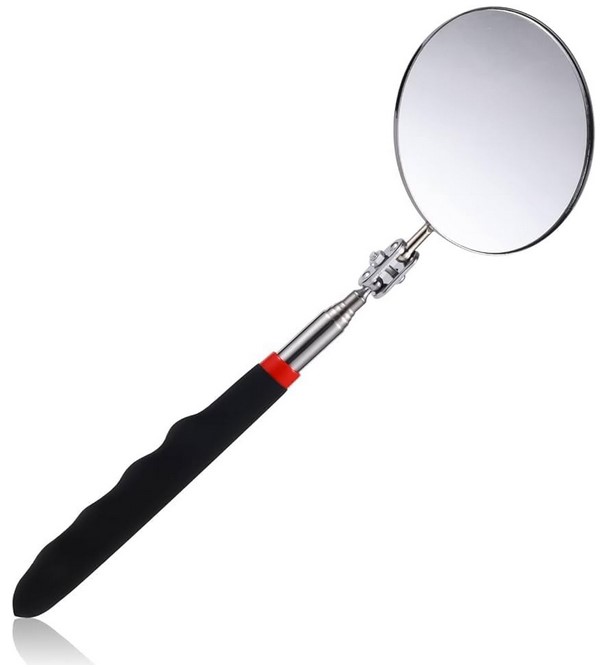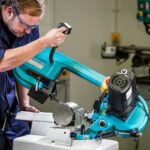An inspection mirror is a specialized tool designed to provide visual access to hard-to-reach or concealed areas. It consists of a mirror mounted on a handle or extension, allowing users to see around corners, behind objects, or into confined spaces. The primary purpose of an inspection mirror is to facilitate thorough inspections and maintenance tasks in various industries and applications.
Inspection mirrors come in handy for mechanics, technicians, plumbers, electricians, and other professionals who often need to inspect and work on components that are not easily visible or accessible. These mirrors enable them to identify potential issues, assess the condition of parts, and perform necessary repairs or maintenance without disassembling or dismantling entire systems.
Common uses of inspection mirrors include:
- Automotive inspections: Mechanics use inspection mirrors to examine the underside of vehicles, engine components, brake systems, and other hard-to-see areas during routine maintenance or repair work.
- HVAC inspections: HVAC technicians employ inspection mirrors to inspect ductwork, vents, and other concealed areas of heating, ventilation, and air conditioning systems.
- Plumbing inspections: Plumbers rely on inspection mirrors to inspect pipes, drains, and other plumbing components that are hidden behind walls or in tight spaces.
- Electrical inspections: Electricians use inspection mirrors to inspect wiring, junction boxes, and other electrical components that are difficult to access or see directly.
- Home inspections: Home inspectors utilize inspection mirrors to examine hard-to-reach areas, such as attics, crawl spaces, and behind appliances or furniture, during property inspections.
Inspection mirrors are versatile tools that aid in thorough inspections, troubleshooting, and maintenance tasks across various industries and applications, ensuring safety and efficiency in accessing and assessing hard-to-reach areas.
Table of Contents
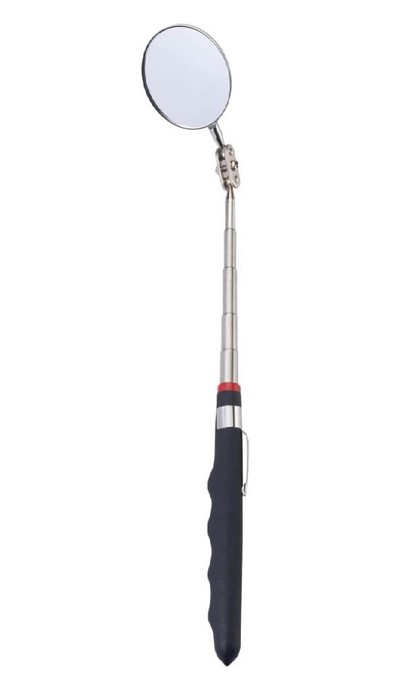
Types of Inspection Mirrors
Inspection mirrors come in various types to suit different applications and preferences. The primary types include:
Rigid Inspection Mirrors: These are the most common and feature a flat, rigid mirror surface attached to a handle. They are ideal for general inspection tasks and can be angled to view hard-to-reach areas. Rigid mirrors are typically made of glass or polished metal and are available in different sizes and handle lengths.
Flexible Inspection Mirrors: These mirrors have a flexible neck or cable that allows the mirror head to bend and maneuver into tight spaces. They are particularly useful for inspecting intricate machinery, plumbing, or automotive components. Flexible mirrors often have a smaller mirror surface and may be made of plastic or metal.
Telescopic Inspection Mirrors: As the name suggests, these mirrors have a telescopic handle that can extend or retract, allowing users to adjust the length as needed. Telescopic mirrors are handy for inspecting hard-to-reach areas, such as inside walls, ceilings, or under vehicles. They may feature rigid or flexible mirror heads.
Dental Inspection Mirrors: Designed specifically for dental professionals, these mirrors have a small, angled mirror head attached to a long, thin handle. They are used to inspect the inside of a patient’s mouth and teeth during dental examinations or procedures.
Lighted Inspection Mirrors: Some inspection mirrors incorporate a built-in light source, typically LED lights, to illuminate the inspection area. These are useful in dimly lit environments or when inspecting dark cavities or spaces.
Inspection mirrors can also vary in terms of materials used for the handle, such as plastic, metal, or wood. Additionally, some mirrors may have specialized coatings or finishes to enhance visibility, reduce glare, or provide scratch resistance.
Applications and Industries
Inspection mirrors are versatile tools used across various industries and applications where visual inspection of hard-to-reach or obscured areas is required. Here are some of the key industries and applications where inspection mirrors find widespread use:
Automotive Industry: Mechanics and automotive technicians rely heavily on inspection mirrors to inspect engine components, undercarriages, brake systems, and other areas that are difficult to access or view directly. These mirrors allow for a thorough inspection without the need for disassembly, saving time and effort.
Plumbing: Plumbers often encounter situations where pipes and fittings are hidden behind walls or in tight spaces. Inspection mirrors enable them to visually inspect these areas for leaks, blockages, or other issues, facilitating accurate diagnoses and efficient repairs.
HVAC (Heating, Ventilation, and Air Conditioning): HVAC technicians use inspection mirrors to inspect ductwork, vents, and other components of heating and cooling systems that are challenging to view directly. These mirrors aid in identifying potential problems and ensuring proper installation and maintenance.
Construction and Building Inspection: Inspection mirrors are invaluable tools for construction professionals and building inspectors. They allow for the examination of structural elements, wiring, insulation, and other components that are concealed or difficult to access, ensuring compliance with building codes and identifying potential issues.
Manufacturing and Quality Control: In manufacturing environments, inspection mirrors are used to inspect the interior of machinery, equipment, and assembled products for defects, wear, or other quality issues. This helps ensure product quality and identify potential problems before they escalate.
Law Enforcement and Security: Law enforcement professionals and security personnel may use inspection mirrors to inspect vehicles, containers, or other areas for hidden compartments, contraband, or potential threats, enhancing safety and security measures.
Home Improvement and DIY Projects: Homeowners and DIY enthusiasts often find inspection mirrors useful for inspecting hard-to-reach areas during home improvement projects, such as examining the interior of walls, crawl spaces, or behind appliances, enabling them to identify and address potential issues.
These are just a few examples of the diverse industries and applications where inspection mirrors play a crucial role in enabling thorough visual inspections and facilitating efficient maintenance, repairs, and quality control processes.
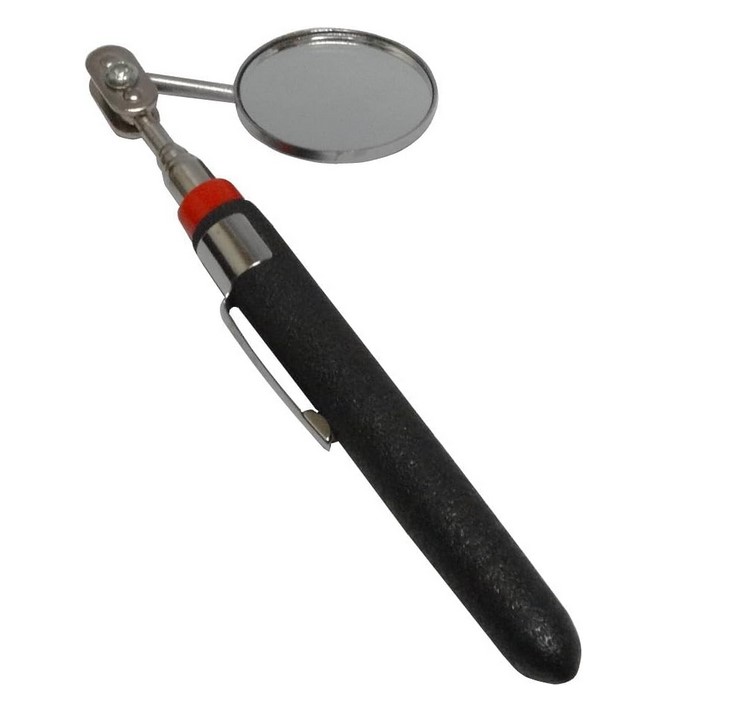
Benefits and Advantages
Inspection mirrors offer numerous benefits and advantages, making them invaluable tools in various industries and applications. One of the primary advantages is enhanced visibility, allowing users to inspect hard-to-reach areas that would otherwise be obscured from view. This improved visibility not only increases efficiency but also promotes safety by enabling thorough inspections and identifying potential issues before they escalate.
Another significant benefit of inspection mirrors is improved accessibility. These specialized mirrors enable users to access confined spaces, tight corners, and hard-to-reach areas without compromising their safety or causing damage to the surrounding environment. This accessibility is particularly crucial in industries such as automotive repair, plumbing, and HVAC, where technicians often encounter cramped spaces and intricate systems.
Safety is a paramount concern in many industries, and inspection mirrors play a vital role in mitigating risks. By providing a clear view of potential hazards or obstructions, these mirrors allow users to make informed decisions and take necessary precautions before proceeding with a task. This proactive approach can prevent accidents, injuries, and costly mistakes, ultimately enhancing workplace safety and reducing downtime.
Inspection mirrors also contribute to time and cost savings. By enabling thorough inspections without disassembling or dismantling components, these mirrors eliminate the need for extensive teardowns, which can be time-consuming and labor-intensive. Additionally, early detection of issues through regular inspections can prevent minor problems from escalating into major repairs or replacements, reducing overall maintenance costs.
Furthermore, inspection mirrors are versatile tools that can be used in a wide range of applications, from automotive and industrial maintenance to home improvement and DIY projects. Their compact size and portability make them easy to carry and use in various settings, ensuring convenience and accessibility for users.
Choosing the Right Inspection Mirror
Selecting the right inspection mirror is crucial for ensuring optimal visibility, safety, and efficiency in various applications. Several factors should be considered when choosing an inspection mirror to meet your specific needs:
Size and Shape: Inspection mirrors come in different sizes and shapes, ranging from compact round or square mirrors to larger rectangular or oval designs. The size and shape should be chosen based on the area you need to inspect and the accessibility of the space. Smaller mirrors are ideal for tight spaces, while larger mirrors provide a wider field of view.
Material: Inspection mirrors are typically made from materials like stainless steel, aluminum, or plastic. Stainless steel and aluminum mirrors are durable and resistant to corrosion, making them suitable for industrial environments or outdoor use. Plastic mirrors are lightweight and cost-effective but may be less durable.
Mirror Surface: The mirror surface can be flat, convex, or a combination of both. Flat mirrors provide a true reflection, while convex mirrors offer a wider viewing angle and can help inspect hard-to-reach areas. Some inspection mirrors feature a dual-surface design, combining a flat and convex mirror on opposite sides.
Lighting: Illuminated inspection mirrors incorporate built-in lighting, such as LED or halogen bulbs, to enhance visibility in low-light conditions or hard-to-reach areas. The type and brightness of the lighting should be considered based on the intended use and environment.
Handle Length: Inspection mirrors often have telescopic or extendable handles, allowing you to reach and inspect areas that are difficult to access directly. Longer handles are beneficial for inspecting hard-to-reach spaces, while shorter handles are more suitable for closer inspections.
Portability and Storage: Consider the portability and storage requirements of the inspection mirror. Compact, foldable, or telescopic designs are ideal for professionals who need to carry the mirror to different job sites or store it in limited spaces.
Durability and Safety: Look for inspection mirrors made from high-quality materials that can withstand the intended use and environmental conditions. Some mirrors may feature non-slip grips, shatterproof designs, or heat-resistant materials for added safety and durability.
By considering these factors, you can select an inspection mirror that meets your specific needs, ensuring optimal visibility, ease of use, and safety in various inspection tasks.
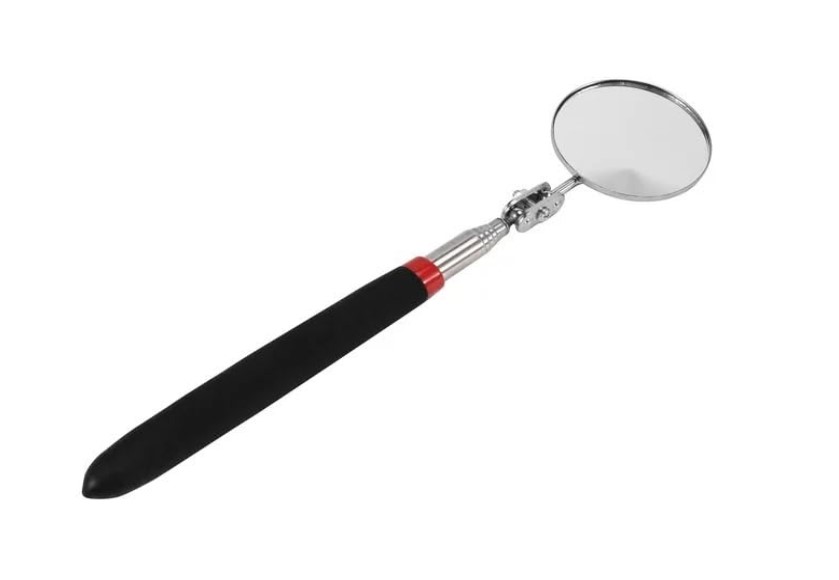
Using Inspection Mirrors Safely
Inspection mirrors are handy tools, but they also pose potential safety risks if not used properly. Here are some essential safety tips and best practices for using inspection mirrors effectively:
- Wear appropriate personal protective equipment (PPE) when using inspection mirrors, such as safety glasses, gloves, and protective clothing, depending on the environment and task.
- Ensure the inspection mirror is securely attached to its handle or extension pole before use. Loose or unstable mirrors can cause accidents or injuries.
- Be cautious when using inspection mirrors in tight spaces or around moving parts, as the mirror or handle could get caught or pinched.
- Maintain a safe distance from the area being inspected, and avoid reaching too far or overextending yourself to prevent strain or loss of balance.
- Never use an inspection mirror near live electrical components or in potentially explosive atmospheres unless the mirror is specifically designed for such environments.
- Keep the inspection area well-lit and free from clutter or obstructions to ensure clear visibility and ease of movement.
- When using telescopic or extendable mirrors, follow the manufacturer’s instructions for proper extension and retraction to prevent damage or injury.
- Regularly inspect the mirror and handle for any cracks, dents, or other signs of wear and tear, and replace them if necessary.
- Train employees on the proper use of inspection mirrors and reinforce safe work practices to prevent accidents and injuries.
By following these safety guidelines and exercising caution, you can use inspection mirrors effectively while minimizing risks and ensuring a safe working environment.
Maintenance and Care
Proper maintenance, cleaning, and storage are essential for ensuring the longevity and optimal performance of inspection mirrors. These tools are designed to withstand harsh environments and frequent use, but they still require care to maintain their reflective surfaces and structural integrity.
Cleaning
Regular cleaning is crucial to keep the mirror surface clear and free from dirt, grime, or residue that can obscure visibility. Use a soft, lint-free cloth dampened with a mild soap and water solution or a specialized mirror cleaning solution. Avoid abrasive cleaners or harsh chemicals, as they can scratch or damage the mirror’s surface. Gently wipe the mirror in a circular motion, ensuring to cover the entire surface.
For stubborn stains or deposits, you can use a small amount of isopropyl alcohol or ammonia-based glass cleaner. Apply it sparingly and buff the mirror with a clean, dry cloth until the stain is removed.
Storage
When not in use, store your inspection mirrors in a clean, dry, and protected environment. Avoid exposing them to extreme temperatures, moisture, or direct sunlight, as these conditions can cause warping, discoloration, or damage to the mirror’s surface or handle.
If your inspection mirror has a telescopic or adjustable handle, ensure it is fully retracted or collapsed before storing to prevent accidental extension or damage.
Handle Care
The handle of an inspection mirror is often made of durable materials like aluminum or stainless steel, but it can still be susceptible to wear and tear. Inspect the handle regularly for any cracks, dents, or loose components, and replace the mirror if the handle is compromised, as it can pose a safety risk.
When using the mirror, avoid applying excessive force or leverage on the handle, as this can cause it to bend or break.
Mirror Surface Protection
The mirror’s surface is delicate and can be easily scratched or damaged. Avoid touching the surface with bare hands or abrasive materials. When not in use, consider covering the mirror surface with a soft, protective cloth or sleeve to prevent accidental scratches or impacts.
By following these maintenance and care guidelines, you can ensure that your inspection mirrors remain in top condition, providing clear and reliable visibility for years to come.
Inspection Mirror Accessories
Inspection mirrors are versatile tools, but their functionality can be further enhanced with the addition of various accessories and attachments. Common accessories include:
Lighting Attachments
Poor lighting conditions can hinder visibility during inspections, making it challenging to examine hard-to-reach areas thoroughly. Lighting attachments, such as LED lights or fiber optic illumination systems, can be mounted directly onto the inspection mirror, providing ample illumination for clear visibility in dimly lit spaces.
Camera Mounts
In some applications, it may be necessary to capture visual records of the inspected area. Camera mounts allow you to securely attach a digital camera or video recorder to the inspection mirror, enabling you to capture high-quality images or videos of the inspection site.
Extension Handles
While many inspection mirrors come with a fixed handle length, extension handles can be attached to increase the reach of the mirror. These accessories are particularly useful when inspecting areas that are difficult to access or when working in tight spaces.
Magnetic Attachments
Magnetic attachments can be added to the inspection mirror to facilitate its use in inspecting ferrous metal surfaces. These attachments allow the mirror to adhere to the inspection surface, freeing up your hands for other tasks or enabling you to position the mirror at the desired angle.
Telescopic Handles
For added versatility, telescopic handles can be attached to inspection mirrors, allowing you to adjust the length of the handle according to the specific inspection requirements. This feature is particularly beneficial when working in confined spaces or when inspecting areas at varying distances.
Specialized Mirrors
In addition to standard inspection mirrors, specialized mirrors are available for specific applications. For example, borescope mirrors are designed for inspecting the interior of pipes, engines, or other cylindrical structures, while dental mirrors are optimized for use in the dental industry.
By utilizing these accessories and attachments, inspection mirrors can be customized to meet the unique demands of various industries and inspection scenarios, enhancing their functionality, efficiency, and overall effectiveness.
Notable Brands and Manufacturers
When it comes to inspection mirrors, there are several brands and manufacturers known for their quality, durability, and innovative designs. These companies have established themselves as leaders in the industry, catering to various professionals and DIY enthusiasts alike.
Titan Tools: Titan Tools is a renowned brand in the automotive and industrial tool market. Their inspection mirrors are known for their rugged construction, featuring heavy-duty materials and ergonomic designs. Titan’s mirrors are often favored by mechanics and technicians for their ability to withstand harsh environments and provide clear visibility in tight spaces.
Lisle: Lisle is a trusted name in the automotive tool industry, offering a wide range of inspection mirrors designed for various applications. Their mirrors are known for their versatility, with telescoping handles and swiveling heads that allow for easy access to hard-to-reach areas. Lisle’s mirrors are popular among mechanics, plumbers, and HVAC professionals.
OTC Tools: OTC Tools is a leading manufacturer of professional-grade tools, including inspection mirrors. Their mirrors are designed with durability and functionality in mind, featuring sturdy construction and innovative features like LED lighting and pivoting heads. OTC’s mirrors are widely used in automotive repair shops, manufacturing facilities, and industrial settings.
Malco Products: Malco Products is a respected brand in the HVAC and construction industries, offering a range of tools and accessories, including inspection mirrors. Their mirrors are designed with ergonomics and user comfort in mind, featuring non-slip grips and adjustable handles. Malco’s mirrors are popular among HVAC technicians, electricians, and plumbers for their versatility and ease of use.
General Tools: General Tools is a well-known manufacturer of precision tools and instruments, including inspection mirrors. Their mirrors are known for their high-quality optics and precise construction, ensuring clear and accurate visibility. General Tools’ mirrors are often used in industrial, manufacturing, and engineering applications where precision is paramount.
These are just a few examples of the notable brands and manufacturers in the inspection mirror market. Each company brings its unique strengths and specializations, catering to the diverse needs of professionals across various industries.
Future Trends and Innovations
The field of inspection mirrors is continuously evolving, driven by advancements in materials science, optics, and imaging technologies. One emerging trend is the integration of digital capabilities into inspection mirrors, allowing for enhanced visual inspection and data capture. Mirrors equipped with high-resolution cameras and connectivity features enable remote viewing, recording, and sharing of inspection footage, streamlining workflows and facilitating collaboration among teams.
Another area of innovation is the development of smart inspection mirrors that leverage artificial intelligence (AI) and machine learning algorithms. These intelligent mirrors can assist in defect detection, pattern recognition, and automated analysis, reducing the risk of human error and improving inspection accuracy and consistency.
The incorporation of augmented reality (AR) technology is also gaining traction in the inspection mirror industry. AR-enabled mirrors can overlay digital information, such as schematics, instructions, or real-time data, directly onto the user’s field of view, enhancing situational awareness and providing valuable context during inspections.
In terms of materials, researchers are exploring the use of advanced composites, lightweight alloys, and specialized coatings to develop more durable, corrosion-resistant, and heat-resistant inspection mirrors. These improvements can extend the lifespan of mirrors and enable their use in harsh environments, such as extreme temperatures or corrosive atmospheres.
Additionally, the integration of wireless connectivity and Internet of Things (IoT) capabilities is expected to revolutionize inspection mirror applications. Connected mirrors can transmit data to centralized systems, enabling remote monitoring, predictive maintenance, and real-time decision-making based on inspection data.
Overall, the future of inspection mirrors lies in the convergence of digital technologies, advanced materials, and intelligent systems, offering enhanced functionality, improved safety, and increased efficiency in various industries.

